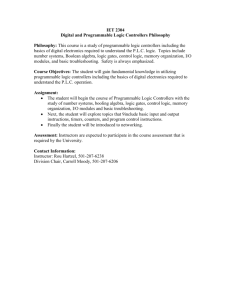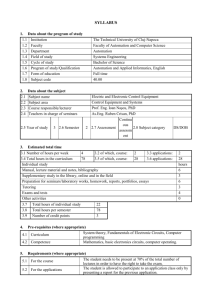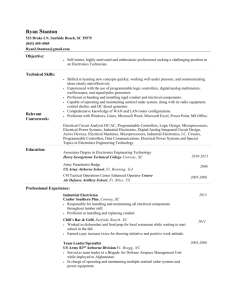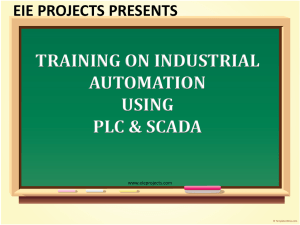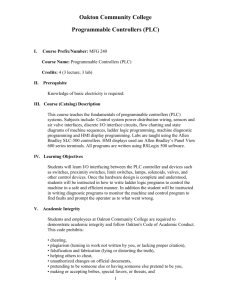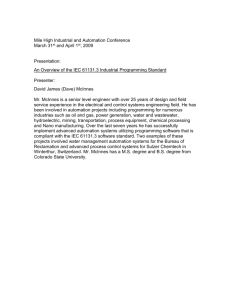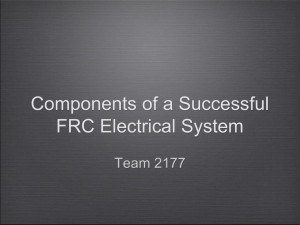Industrial Automation
advertisement
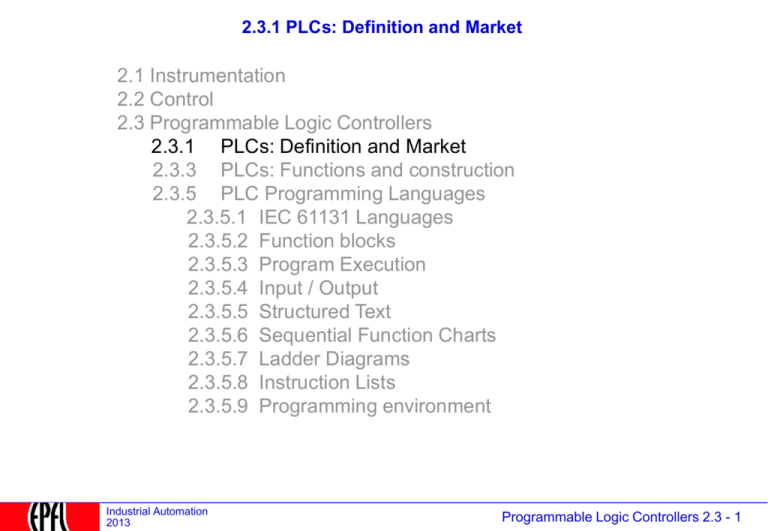
2.3.1 PLCs: Definition and Market
2.1 Instrumentation
2.2 Control
2.3 Programmable Logic Controllers
2.3.1 PLCs: Definition and Market
2.3.3 PLCs: Functions and construction
2.3.5 PLC Programming Languages
2.3.5.1 IEC 61131 Languages
2.3.5.2 Function blocks
2.3.5.3 Program Execution
2.3.5.4 Input / Output
2.3.5.5 Structured Text
2.3.5.6 Sequential Function Charts
2.3.5.7 Ladder Diagrams
2.3.5.8 Instruction Lists
2.3.5.9 Programming environment
Industrial Automation
2013
Programmable Logic Controllers 2.3 - 1
PLC = Programmable Logic Controller: Definition
AP = Automates Programmables industriels
SPS = Speicherprogrammierbare Steuerungen
Definition:
“small computers, dedicated to automation tasks in an industrial environment"
Formerly:
cabled relay control (hence 'logic'), analog (pneumatic, hydraulic) “governors”
Today:
real-time (embedded) computer with extensive input/output
Function:
Measure, Control, Protect
Distinguish
Instrumentation
flow meter, temperature, position,…. but also actors (pump, …)
Control
programmable logic controllers with digital peripherals & field bus
Visualization
Human Machine Interface (HMI) in PLCs (when it exists) is limited
to service help and control of operator displays
Industrial Automation
2013
Programmable Logic Controllers 2.3 - 2
Simple PLC
network
digital inputs
analog inputs / outputs
digital outputs
Industrial Automation
2013
Programmable Logic Controllers 2.3 - 3
PLC in a cabinet
CPU1
CPU2
serial connections
redundant field
bus connection
inputs/outputs
Industrial Automation
2013
Programmable Logic Controllers 2.3 - 4
example: turbine control (in the test lab)
Industrial Automation
2013
Programmable Logic Controllers 2.3 - 5
PLC: functions
(Messen, Schützen, Regeln = MSR)
PLC = PMC: Protection, Measurement and Control
• Measure
• Control (Command and Regulation)
• Protection
•Event Logging
•Communication
•Human interface
Industrial Automation
2013
Programmable Logic Controllers 2.3 - 6
PLC: Characteristics
• large number of peripherals: 20..100 I/O per CPU, high density of wiring, easy assembly.
• digital and analog Input/Output with standard levels
• operate under harsh conditions, require robust construction, protection against dirt,
water and mechanical threats, electro-magnetic noise, vibration, extreme temperature
range (-30C..85C), sometimes directly located in the field.
• programming: either very primitive with hand-help terminals on the target machine
itself, or with a laptop
• network connection for programming on workstations and connection to SCADA
• field bus connection for remote I/Os
• primitive Human-Machine-Interface for maintenance, either through LCD-display or
connection of a laptop over serial lines (RS232) or wireless.
• economical - €1000.- .. €15'000.- for a full crate.
• the value is in the application software (licenses €20'000 ..€50'000)
Industrial Automation
2013
Programmable Logic Controllers 2.3 - 7
PLC: Location in the control architecture
Enterprise Network
Engineer
station
Operator
station
Supervisor
Station
gateway
direct I/O
Industrial Automation
2013
Field Stations
COM 2
CPU
I/O
gateway
COM
CPU
COM
I/O
I/O
COM
I/O
CPU
COM
I/O
I/O
I/O
I/O
CPU
PLC
Field Bus
FB
gateway
small PLC
data concentrators,
not programmable,
but configurable
COM1
I/O
Control Station
with Field Bus
Field Bus
COM
directly connected
I/O
I/O
I/O
I/O
COM 2
COM1
PLC
CPU
I/O
I/O
I/O
I/O
I/O
COM1
large
PLCs
CPU
Control Bus
(e.g. Ethernet)
Field Devices
Sensor Bus (e.g. ASI)
Programmable Logic Controllers 2.3 - 8
Why 24V / 48 V supply ?
… After the plant lost
electric power, operators
could read instruments only
by plugging in temporary
batteries…
[IEEE Spectrum Nov 2011
about Fukushima]
Photo TEPCO
Industrial Automation
2013
Programmable Logic Controllers 2.3 - 9
Global players
Total sales in 2004: 7’000 Mio €
Source: ARC Research, 2005-10
Industrial Automation
2013
Programmable Logic Controllers 2.3 - 10
Kinds of PLC
(1)
Compact
Monolithic construction
Monoprocessor
Fieldbus connection
(2)
Modular PLC
Modular construction (backplane)
One- or multiprocessor system
Fieldbus and LAN connection
Small Micro Memory Card (MMC) function possible
(3)
Soft-PLC
Linux or Windows NT or CE-based automation products
Direct use of CPU or co-processors
Industrial Automation
2013
Programmable Logic Controllers 2.3 - 11
Compact PLC
courtesy ABB
courtesy ABB
courtesy ABB
Monolithic (one-piece) construction
Fixed casing
Fixed number of I/O (most of them binary)
No process computer capabilities (no MMC)
Can be extended and networked by an extension (field) bus
Sometimes LAN connection (Ethernet, Arcnet)
Monoprocessor
Typical product: Mitsubishi MELSEC F, ABB AC31, SIMATIC S7
costs: € 2000
Industrial Automation
2013
Programmable Logic Controllers 2.3 - 12
Specific Controller (example: Turbine)
tailored for a specific application, produced in large series
Programming port
Relays and fuses
Thermocouple
inputs
binary I/Os,
CAN field bus
RS232 to HMI
courtesy Turbec
cost: € 1000.-
Industrial Automation
2013
Programmable Logic Controllers 2.3 - 13
Modular PLC
• can be tailored to needs of application
development
environment
RS232
• housed in a 19" (42 cm) rack
(height 6U ( = 233 mm) or 3U (=100mm)
• high processing power (several CPUs)
LAN
• large choice of I/O boards
backplane
parallel bus
• concentration of a large number of I/O
courtesy ABB
• interface boards to field busses
fieldbus
• requires marshalling of signals
Power Supply
• primitive or no HMI
• cost effective if the rack can be filled
CPU CPU
Analog I/O
Binary I/O
fieldbus
• supply 115-230V~ , 24V= or 48V= (redundant)
• cost ~ €10’000 for a filled crate
Typical products: SIMATIC S5-115, Hitachi H-Serie, ABB AC110
Industrial Automation
2013
Programmable Logic Controllers 2.3 - 14
Small modular PLC
courtesy ABB
courtesy Backmann
mounted on DIN-rail, 24V supply
cheaper (€5000)
not water-proof,
no ventilator
extensible by a parallel bus (flat cable or rail)
Industrial Automation
2013
Programmable Logic Controllers 2.3 - 15
Compact or modular ?
field bus
extension
€
compact PLC
(fixed number of I/Os)
modular PLC (variable number of I/Os
Limit of local I/O
# I/O modules
Industrial Automation
2013
Programmable Logic Controllers 2.3 - 16
Industry- PC
courtesy INOVA
courtesy MPI
Wintel architecture
(but also: Motorola, PowerPC),
HMI (LCD..)
Limited modularity through mezzanine boards
(PC104, PC-Cards, IndustryPack)
Backplane-mounted versions with PCI or Compact-PCI
Industrial Automation
2013
Competes with modular PLC
no local I/O,
fieldbus connection instead,
costs: € 2000.-
Programmable Logic Controllers 2.3 - 17
Soft-PLC (PC as PLC)
23
4
3
3
2
12
2
• PC as engineering workstation
• PC as human interface (Visual Basic, Intellution, Wonderware)
• PC as real-time processor
• PC assisted by a Co-Processor (ISA- or PC104 board)
• PC as field bus gateway to a distributed I/O system
I/O modules
Industrial Automation
2013
Programmable Logic Controllers 2.3 - 18
Protection devices
substation
measurement
transformers
communication to operator
Ir
Is
It
Ur
Us
UT
Human interface
for status
and
settings
Programming
interface
trip relay
Protection devices are highly specialized PLCs that measure the current and voltages in an electrical
substation, along with other statuses (position of the switches,…) to detect situations that could
endanger the equipment (over-current, short circuit, overheat) and trigger the circuit breaker (“trip”) to
protect the substation.
In addition, they record disturbances and send the reports to the substation’s SCADA.
Sampling: 4.8 kHz, reaction time: < 5 ms.
costs: € 5000
Industrial Automation
2013
Programmable Logic Controllers 2.3 - 19
Comparison Criteria – what matters
Brand
Siemens
Hitachi
Number of Points
Memory
1024
10 KB
640
16 KB
Programming Language
• Ladder Diagrams
• Instruction List
• Logic symbols
• Hand-terminal
• Ladder Diagrams
• Instruction List
• Logic symbols
• Basic
• Hand-terminal
Programming Tools
Download
Graphical (on PC)
no
Graphical (on PC)
yes
Real estate per 250 I/O
2678 cm2
1000 cm2
Label surface
per line/point
5.3 mm2
7 characters
6 mm2
6 characters
Network
10 Mbit/s
19.2 kbit/s
Mounting
DIN rail
cabinet
Industrial Automation
2013
Programmable Logic Controllers 2.3 - 20
2.3.3 PLCs: Function and construction
2.1 Instrumentation
2.2 Control
2.3 Programmable Logic Controllers
2.3.1 PLCs: Definition and Market
2.3.3 PLCs: Functions and construction
2.3.5 PLC Programming Languages
2.3.5.1 IEC 61131 Languages
2.3.5.2 Function blocks
2.3.5.3 Program Execution
2.3.5.4 Structured Text
2.3.5.5 Sequential Function Charts
2.3.5.6 Ladder Diagrams
2.3.5.7 Instruction Lists
2.3.5.8 Programming environment
Industrial Automation
2013
Programmable Logic Controllers 2.3 - 21
Implementation
• PLC operates periodically
• Samples signals from sensors and converts them to digital form with
A/D converter
• Computes control signal and converts it to analog form for the
actuators.
1. Wait for clock interrupt
2. Read input from sensor
3. Compute control signal
4. Send output to the actuator
5. Update controller variables
7. Communication
6. Repeat
Waiwera Organic Winery, Distillation Plant
Industrial Automation
2013
Programmable Logic Controllers 2.3 - 22
The signal chain within a PLC
y(i)
y
time
analog
variable
(e.g. 4..20mA)
time
filtering
&
scaling
sampling
analogdigital
converter
1
binary
variable
y(i)
filtering
011011001111
counter
amplifier
analog
variable
e.g. -10V..10V
transistor
or
relay
0001111
y
digitalanalog
converter
processing
sampling
(e.g. 0..24V)
time
binary
variable
non-volatile
memory
time
Industrial Automation
2013
Programmable Logic Controllers 2.3 - 23
General PLC architecture
RS 232
CPU
Real-Time
Clock
ROM
flash
EPROM
serial port
controller
Ethernet
ethernet
controller
extension
bus
parallel bus
fieldbus
controller
buffers
analogdigital
converters
digitalanalog
converters
Digital Output
Digital
Input
signal
conditioning
power
amplifiers
relays
signal
conditioning
external
I/Os
direct Inputs and Outputs
field bus
Industrial Automation
2013
Programmable Logic Controllers 2.3 - 24
Example Architecture: Internals of a protection device
Can you find all the components from the previous slide?
In addition this device uses a DSP module for complex computations.
Industrial Automation
2013
Programmable Logic Controllers 2.3 - 25
2.3.5 Programming languages
2.1 Instrumentation
2.2 Control
2.3 Programmable Logic Controllers
2.3.1 PLCs: Definition and Market
2.3.3 PLCs: Functions and construction
2.3.5 Programming languages
2.3.5.1 IEC 61131 Languages
2.3.5.2 Function blocks
2.3.5.3 Program Execution
2.3.5.4 Input / Output
2.3.5.5 Structured Text
2.3.5.6 Sequential Function Charts
2.3.5.7 Ladder Diagrams
2.3.5.8 Instruction Lists
2.3.5.9 Programming environment
Industrial Automation
2013
Programmable Logic Controllers 2.3 - 26
The long march to IEC 61131
PLC industry needs aggreement on
• Data types (operations may only be executed on appropriate types)
• Programming languages
• Software structure (program organization units for modularity, encapsulation)
• Discrete event system handling
• Execution
NEMA Programmable Controllers Committee formed (USA)
GRAFCET (France)
DIN 40719, Function Charts (Germany)
NEMA ICS-3-304, Programmable Controllers (USA)
IEC SC65A/WG6 formed
DIN 19 239, Programmable Controller (Germany)
IEC 65A(Sec)38, Programmable Controllers
MIL-STD-1815 Ada (USA)
IEC SC65A(Sec)49, PC Languages
IEC SC65A(Sec)67
IEC 848, Function Charts
IEC 64A(Sec)90
IEC 1131-3
it took 20 years to make that standard…
Type 3 report
recommendation
IEC 61131-3
name change
70
77
78
79
80
81
82
83
84
85
86
87
88
89
90
91
92
93
94
95
96
Source: Dr. J. Christensen
Industrial Automation
2013
Programmable Logic Controllers 2.3 - 27
Matching the analog and binary world
Binary World
Analog World
Pneumatic and electromechanical
controllers
Relay control, pneumatic
sequencer
I1
A
B
C
P1
P2
combinatorial
Regulation, controllers
continuous processes
sequential
discrete processes
Described by variables of nonoverlapping values. The transition from
one state to another is abrupt, it is
caused by an external event.
The time constant of the control
system must be at least one order
of magnitude smaller than the
smallest time constant of the plant.
PLC
Industrial Automation
2013
Programmable Logic Controllers 2.3 - 28
"Real-Time" languages
Extend procedural languages to
express time
Languages developed for cyclic
execution and real-time
("application-oriented languages")
(“introduce programming constructs to
influence scheduling and control flow”)
• ADA
•
Ladder Diagrams
• Real-Time Java
•
function block language
• MARS (TU Wien)
•
instruction lists
• Forth
•
GRAFCET
• “C” with real-time features
•
SDL
• etc…
could not impose themselves
Industrial Automation
2013
etc...
wide-spread in the control industry.
Now standardized as IEC 61131
Programmable Logic Controllers 2.3 - 29
The five IEC 61131-3 Programming languages
graphical languages
Function Block Diagram (FBD)
http://www.isagraf.com
Sequential Flow Chart (SFC)
CALC1
PUMP
CALC
AUTO
>=1
IN1 OUT
DO
START STEP
T1
V
MAN_ON
STEP A
IN2
ACT
N
ACTION D1
D1_READY
D
ACTION D2
D2_READY
N
ACTION D3
D3_READY
D
ACTION D4
D4_READY
T2
STEP B
Ladder Diagram (LD)
T3
CALC1
AUTO
CALC
IN1 OUT
OUT
PUMP
ACT
IN2
MAN_ON
Instruction List (IL)
A: LD
%IX1 (* PUSH BUTTON *)
ANDN %MX5 (* NOT INHIBITED *)
ST
%QX2 (* FAN ON *)
Industrial Automation
2013
textual languages
Structured Text (ST)
VAR CONSTANT X : REAL := 53.8 ;
Z : REAL; END_VAR
VAR aFB, bFB : FB_type; END_VAR
bFB(A:=1, B:=‘OK’);
Z := X - INT_TO_REAL (bFB.OUT1);
IF Z>57.0 THEN aFB(A:=0, B:=“ERR”);
ELSE aFB(A:=1, B:=“Z is OK”);
END_IF
Programmable Logic Controllers 2.3 - 30
61131 Elementary Data Types
No.
1
2
3
4
5
6
7
8
9
10
11
12
13
14
15
16
17
18
19
20
Keyword
BOOL
SINT
INT
DINT
LINT
USINT
UINT
UDINT
ULINT
REAL
LREAL
TIME
DATE
TIME_OF_DAY or TOD
DATE_AND_TIME or DT
STRING
BYTE
WORD
DWORD
LWORD
Industrial Automation
2013
Data Type
Bits
Boolean
Short integer
Integer
Double integer
Long integer
Unsigned short integer
Unsigned integer
Unsigned double integer
Unsigned long integer
Real numbers
Long reals
Duration
Date (only)
Time of day (only)
Date and time of day
Character string
Bit string of length 8
Bit string of length 16
Bit string of length 32
Bit string of length 64
1
8
16
32
64
8
16
32
64
32
64
variable
variable
variable
variable
variable
8
16
32
64
Programmable Logic Controllers 2.3 - 31
Importance of IEC 61131
IEC 61131-3 is the most important automation language in industry.
80% of all PLCs support it, all new developments are based on it.
Depending on the country, some languages are more popular than others.
More information:
http://www.plcopen.org/pages/tc1_standards/downloads/plcopen_iec611313_feb2014.pptx
http://www.plcopen.org/pages/pc2_training/downloads/index.htm
Industrial Automation
2013
Programmable Logic Controllers 2.3 - 32
2.3.5.2 Input and Output
2.1 Instrumentation
2.2 Control
2.3 Programmable Logic Controllers
2.3.1 PLCs: Definition and Market
2.3.3 PLCs: Functions and construction
2.3.5 PLC Programming Languages
2.3.5.1 IEC 61131 Languages
2.3.5.2 Input & Output
2.3.5.3 Function blocks
2.3.5.4 Program Execution
2.3.5.5 Structured Text
2.3.5.6 Sequential Function Charts
2.3.5.7 Ladder Diagrams
2.3.5.8 Instruction Lists
2.3.5.9 Programming environment
Industrial Automation
2013
Programmable Logic Controllers 2.3 - 33
Connecting to Input/Output, Method 1: dedicated I/O blocks
The Inputs and Outputs of the PLC must be connected to (typed) variables
IN_1
OUT_1
The I/O blocks are configured to be attached to the
corresponding I/O groups.
Industrial Automation
2013
Programmable Logic Controllers 2.3 - 34
Connecting to Input / Output, Method 2: Variables configuration
All program variables must be declared with name and type, initial value and volatility.
A variable may be connected to an input or an output, giving it an I/O address.
Several properties can be set: default value, fall-back value, store at power fail,…
These variables may not be connected as input, resp. output to a function block.
predefined addresses
Industrial Automation
2013
Programmable Logic Controllers 2.3 - 35
2.4.2.3 Function Blocks Language
2.1 Instrumentation
2.2 Control
2.3 Programmable Logic Controllers
2.3.1 PLCs: Definition and Market
2.3.3 PLCs: Functions and construction
2.3.5 PLC Programming Languages
2.3.5.1
IEC 61131 Languages
2.3.5.2
Input / Output
2.3.5.3
Function blocks language
2.3.5.4
Program Execution
2.3.5.5
Structured Text
2.3.5.6
Sequential Function Charts
2.3.5.7
Ladder Diagrams
2.3.5.8
Instruction Lists
2.3.5.9
Programming environment
Industrial Automation
2013
Programmable Logic Controllers 2.3 - 36
Function Block Languages
(Funktionsblocksprache, langage de blocs de fonctions)
(Also called "Function Chart" or "Function Plan" - FuPla)
The function block languages express "combinatorial"
programs in a way similar to electronic circuits.
They draw on a large variety of predefined and custom functions
This language is similar to the Matlab / Simulink language
used for simulations
Industrial Automation
2013
Programmable Logic Controllers 2.3 - 37
Function Block Examples
Example 1:
A
B
&
C
Example 2:
external outputs
external inputs
Trigger
Tempo
&
S Q
Spin
Running
Reset
R
Graphical programming language, similar to electrical and block
diagrams. Mostly expresses combinatorial logic, but blocks may have
memory (e.g. RS-flip-flops)
Industrial Automation
2013
Programmable Logic Controllers 2.3 - 38
Function Block Elements
Function block
input signals
Example
set point
measurement
parameters output signals
PID
command
overflow
"continuously"
executing block,
independent,
no side effects
The block is defined by its:
• Data flow interface (number and type of input/output signals)
• Black-Box-Behavior (functional semantic, e.g. in textual form).
Signals
Typed connections that carry a pseudo-continuous data flow.
Connects the function blocks.
set point
Example
Industrial Automation
2013
(set point)
(set point)
Programmable Logic Controllers 2.3 - 39
Function Block Example
Industrial Automation
2013
Programmable Logic Controllers 2.3 - 40
Function Block Rules
There exist exactly two rules for connecting function blocks by signals
(this is the actual programming):
• Each signal is connected to exactly one source.
This source can be the output of a function block or a plant signal.
• The type of the output pin, the type of the input pin and the signal type
must be identical.
The function plan should be drawn so the signals flow from left
to right and from top to bottom. Some editors impose additional rules.
Retroactions are an exception to this rule. In this case, the signal direction is
identified by an arrow (forbidden in some editors – use global variables instead).
a
b
x
z
c
Industrial Automation
2013
y
Programmable Logic Controllers 2.3 - 41
Types of Programming Organisation Units (POUs)
1) “Functions”
- are part of the base library.
- have no memory.
Examples: and gate, adder, multiplier, selector,....
2) “Elementary Function Blocks” (EFB)
- are part of the base library
- have a memory ("static" data).
- may access global variables (side-effects !)
Examples: counter, filter, integrator,.....
3) “Programs” (Compound blocks)
- user-defined or application-specific blocks
- may have a memory
- may be configurable (control flow not visible in the FBD
Examples: PID controller, Overcurrent protection, Motor sequence
(a library of compound blocks may be found in IEC 61804-1)
Industrial Automation
2013
Programmable Logic Controllers 2.3 - 42
Function Block library
The programmer chooses the blocks in a block library, similarly to the
hardware engineer who chooses integrated circuits in a catalogue.
The library describes the pinning of each block, its semantics and the
execution time.
The programmer may extend the library by defining function block macros
composed of library elements.
If some blocks are used often, they will be programmed in an external
language (e.g. “C”, micro-code) following strict rules.
Industrial Automation
2013
Programmable Logic Controllers 2.3 - 43
Library functions for discrete and continuous plants
Basic blocks
logical operations(AND, OR, …)
Flip-flop
Selector m-out-of-n
Multiplexer m-to-n
Timer
Counter
Memory
Sequencing
Compound blocks
Display
Manual input, touch-screen
Safety blocks (interlocking)
Alarm signaling
Logging
Industrial Automation
2013
Basic blocks
Summator / Subtractor
Multiplier / Divider
Integrator / Differentiator
Filter
Minimal value, Maximum value
Radix
Function generator
Regulation Functions
P, PI, PID, PDT2 controller
Fixed set-point
Ratio and multi-component regulation
Parameter variation / setting
2-point regulation
3-point regulation
Output value limitation
Ramp generator
Adaptive regulation
Drive Control
Programmable Logic Controllers 2.3 - 44
Function Block library for specialized applications
MoveAbsolute
AXIS_REF
BOOL
REAL
REAL
REAL
REAL
REAL
MC_Direction
Axis
Execute
Position
Velocity
Acceleration
Deceleration
Jerk
Direction
Axis
Done
CommandAborted
Error
ErrorID
AXIS_REF
BOOL
BOOL
BOOL
WORD
standardized blocks are defined in libraries, e.g. Motion Control or Robotics
Industrial Automation
2013
Programmable Logic Controllers 2.3 - 45
Specifying the behaviour of Function Block
Time Diagram:
0
T
y
x
x
y
T
Truth Table:
x1
x2
Mathematical Formula:
Textual Description:
Industrial Automation
2013
x
x1
x2
y
S
0
0
previous state
R
0
1
0
1
0
1
1
1
1
t
dx
Kpx Kd Ki xd
dt
0
y
Calculates the root mean square of the input with a filtering constant
defined in parameter „FilterDelay“
Programmable Logic Controllers 2.3 - 46
Function Block specification in Structured Text
Industrial Automation
2013
Programmable Logic Controllers 2.3 - 47
IEC 61131-3 library (extract)
Boolean Functions
Selector
Arithmetic Functions
Binary
selection
Select one of N
inputs depending
on input K
Flip-flop
Up counter
dominant set
Q:=S1|(Q&!R)
dominant reset
Q:=!R1&(Q|S)
Trigger
rising edge
detector
CU – input (rising
edges count up)
R – reset counter
(CV:=0)
PV – preset value
Q – 1 if CV >= PV
CV – current value
ADD
adder
SUB
subtractor
MUL
multiplier
DIV
divider
INT
Reset
PV
In
Integrator
(if reset)
Out := PV,
else
Out:= Δt *In +
Out
More details http://calc1.kss.ia.polsl.pl/content/dydaktyka/PC/PLC_IEC61131-3.pdf
Industrial Automation
2013
Programmable Logic Controllers 2.3 - 48
Exercise: What do the following blocks do ? (Δt = 1)
2.
1.
In1
(1024)
In
ADD
(10)
Out
(initially 2)
DIV
In2
INT
Reset = 0
PV
In
Out
(initially 0)
(2)
What are the values of Out?
What happens if out is initially 1024?
What are the values
of Out?
3.
Remember:
INT
If (Reset) :
Out := PV,
Else:
Out := Δt *In + Out
t1
CTU
CU
RESET Q
CV
PV
t2
t3 t4 t5 t6
t7
t8
CU
Reset = 0, PV = 3, CV = #up Q = (CV >= PV) ?
Flipflop: dominant set or reset?
4.
SR
S
S1
R
R
Q
RS
S
R1
Q
Q
dominant set
Q:=S1|(Q&!R)
dominant reset
Q:=!R1&(Q|S)
http://tinyurl.com/IAFunctionBlock
https://docs.google.com/forms/d/1ynmoXf3JTcRn2yv2_4bKhcK0HJNDYpiTnQQm13lDSso/viewform
Industrial Automation
2013
Programmable Logic Controllers 2.3 - 49
Exercise: What do the following blocks do ?
1.
2.
2, 12, 22, 32, 42
If out is initially 0:
0, 0, 0, 0, 0
If out is initially 1024: 1024, 1024, 1024,
3.
CV = 1, 1, 2, 2, 3, 3, 4, 4
Q = 0, 0, 0, 0, 1, 1, 1, 1
4.
S
SR
S1
R
R
Q
dominant set
Q:=S1|(Q&!R)
Q
https://docs.google.com/forms/d/1ynmoXf3JTcRn2yv
2_4bKhcK0HJNDYpiTnQQm13lDSso/viewform
Industrial Automation
2013
ftp://advantechdownloads.com/Traini
ng/KW%20training/
Programmable Logic Controllers 2.3 - 50
Exercise: Asymmetric Sawtooth Wave
Build an asymmetric sawtooth wave generator with
IEC 61131 function blocks
5s
12s
75
0
-25
Industrial Automation
2013
Programmable Logic Controllers 2.3 - 51
Exercise: Asymmetric Sawtooth Wave
Build an asymmetric sawtooth wave generator with
IEC 61131 function blocks
5s
12s
75
0
-25
Hints:
- Compute the slopes
- Use integrators, comparators, flip-flops and selectors
Industrial Automation
2013
Programmable Logic Controllers 2.3 - 52
Exercise: Saw-tooth FBD
Out
75.0
0
-25.0
+ 8.3
-20.0
Other solutions exists.
Industrial Automation
2013
Programmable Logic Controllers 2.3 - 53
Function Block decomposition
A function block describes a data flow interface.
Its body can be implemented differently:
Elementary block
The body is implemented in an external language
(micro-code, assembler, IEC 61131 ST):
=
Compound block
procedure xy (a,b:BOOLEAN; VAR b,c: BOOLEAN);
begin
......
....
end xy;
The body is realized as a function block program
.
Each input (output) pin of the interface is implemented as
exactly one input (output) of the function block.
All signals must appear at the interface to guarantee
freedom from side effects.
=
Industrial Automation
2013
Programmable Logic Controllers 2.3 - 54
Function Block segmentation
An application program (task) is decomposed into segments ("Programs")
for easier reading, each segment being represented on one (A4) printed page.
• Within a segment, the connections are represented graphically
.
• Between the segments, the connections are expressed by signal names
.
Segment A
X1
M2
M1
Y1
Segment B
X2
Y2
M1
X3
Industrial Automation
2013
M2
Programmable Logic Controllers 2.3 - 55
2.3.5.3 Program execution
2.1 Instrumentation
2.2 Control
2.3 Programmable Logic Controllers
2.3.1 PLCs: Definition and Market
2.3.3 PLCs: Functions and construction
2.3.5 PLC Programming Languages
2.3.5.1 IEC 61131 Languages
2.3.5.2 Function blocks
2.3.5.3 Program Execution
2.3.5.4 Input / Output
2.3.5.5 Structured Text
2.3.5.6 Sequential Function Charts
2.3.5.7 Ladder Diagrams
2.3.5.8 Instruction Lists
2.3.5.9 Programming environment
Industrial Automation
2013
Programmable Logic Controllers 2.3 - 56
Execution of Function Blocks
Segment or POU
(program organization unit)
A
B
C
F1
The function blocks are
translated to machine language
(intermediate code, IL),
that is either interpreted or
compiled to assembly language
Blocks are executed in sequence,
normally from upper left to lower right
The sequence is repeated every t ms.
Industrial Automation
2013
X
F2
F4
F3
Machine Code:
X01
X02
function
input1
input2
output
Y
F1
A
B
X01
F2
X01
X
F3
B
C
X02
F4
X
X02
Y
Programmable Logic Controllers 2.3 - 57
Input-Output of Function Blocks
Run-time:
read
inputs
I
write
outputs
X
execute
O
I
X
O
individual period
I
X
O
time
The function blocks are executed cyclically.
• all inputs are read from memory or from the plant (possibly cached)
• the segment is executed
• the results are written into memory or to the plant (possibly to a cache)
The order of execution of the blocks generally does not matter.
To speed up algorithms and avoid cascading, it is helpful to impose an
execution order to the blocks.
The different segments may be assigned a different individual period.
Industrial Automation
2013
Programmable Logic Controllers 2.3 - 58
Program configuration
The programmer divides the program into tasks (sometimes called
pages or segments), which may be executed each with a different
period.
The programmer assigns each task (each page) an execution
period. Since the execution time of each block in a task is fixed, the
execution time is fixed.
Event-driven operations are encapsulated into blocks, e.g. for
transmitting messages.
If the execution time of these operations take more than one period,
they are executed in background.
The periodic execution always has the highest priority.
Industrial Automation
2013
Programmable Logic Controllers 2.3 - 59
IEC 61131 - Execution engine
configuration
resource
resource
task
task
program
program
FB
task
task
program
program
FB
FB
global and directly
FB
represented variables
access paths
communication function
Legend:
FB
execution control path
variable access paths
function block
variable
Industrial Automation
2013
Programmable Logic Controllers 2.3 - 60
Parallel execution
Function blocks are particularly well suited for true multiprocessing (parallel
processors).
The performance limit is given by the needed exchange of signals by shared memory.
Semaphores are not used since they could block an execution and make the concerned
processes non-deterministic.
processor
1
processor
2
processor
3
input/
output
shared
memory
shared
memory
shared
memory
shared
memory
Industrial Automation
2013
Programmable Logic Controllers 2.3 - 61
2.3.5.5 Structured Text
2.1 Instrumentation
2.2 Control
2.3 Programmable Logic Controllers
2.3.1 PLCs: Definition and Market
2.3.3 PLCs: Functions and construction
2.3.5 PLC Programming Languages
2.3.5.1 IEC 61131 Languages
2.3.5.2 Function blocks
2.3.5.3 Program Execution
2.3.5.4 Input / Output
2.3.5.5 Structured Text
2.3.5.6 Sequential Function Charts
2.3.5.7 Ladder Diagrams
2.3.5.8 Programming environment
Industrial Automation
2013
Programmable Logic Controllers 2.3 - 62
Structured Text
(Strukturierte Textsprache, langage littéral structuré)
Structured Text is an imperative language similar to Pascal (If, While, etc..)
The variables defined in ST can be used in other languages
ST is used to do complex data manipulation and write blocks
Caution: writing programs in structured text can breach the real-time rules !
Industrial Automation
2013
Programmable Logic Controllers 2.3 - 63
Data Types
Function Blocks are typed: the types of connection, input and output must match.
•Elementary Types are defined either in Structured Text or in the FB configuration.
analog types:
binary types:
BOOL
BYTE
WORD
DWORD
1
8
16
32
REAL
LREAL
(Real32)
(Real64)
•Derived Types are user-defined and must be declared in Structured Text
subrange,
enumerated,
arrays,
structured types
(e.g. AntivalentBoolean2)
Variables can receive initial values and be declared as non-volatile (RETAIN), so
after restart they contain the last value before power-down or reset.
Industrial Automation
2013
Programmable Logic Controllers 2.3 - 64
Example of Derived Types
TYPE
ANALOG_CHANNEL_CONFIGURATION
STRUCT
RANGE: ANALOG_SIGNAL_RANGE;
MIN_SCALE : ANALOG_DATA ;
MAX_SCALE : ANALOG_DATA ;
END_STRUCT;
ANALOG_16_INPUT_CONFIGURATION :
STRUCT
SIGNAL_TYPE : ANALOG_SIGNAL_TYPE;
FILTER_CHARACTERISTIC : SINT (0.99)
CHANNEL: ARRAY [1..16] OF ANALOG_CHANNEL_CONFIGURATION;
END_STRUCT ;
END_TYPE
Industrial Automation
2013
Programmable Logic Controllers 2.3 - 65
Structured Text Examples
IF tank.temp > 200 THEN
pump.fast :=1;
pump.slow :=0;
pump.off :=0;
ELSIF tank.temp > 100 THEN
pump.fast :=0;
pump.slow :=1;
pump.off :=0;
ELSE
pump.fast :=0;
pump.slow :=0;
pump.off :=1;
END_IF;
IF( Switch_0 AND Switch_1 ) THEN
Start_Motor := 1;
Start_Count := Start_Count + 1;
END_IF;
pos := 0;
WHILE((pos < 100)
& s_arr[pos].value <> target)) DO
pos := pos + 2;
String_tag.DATA[pos] :=
SINT_array[pos];
END_WHILE;
Predefined functions, e.g.:
SIZE(SINT_array, 0, SINT_array_size);
Count the number of elements in SINT_array (array that contains inputs) and store
result in SINT_array_size (DINT tag).
[http://literature.rockwellautomation.com/idc/groups/literature/documents/pm/1756-pm007_-en-p.pdf]
Industrial Automation
2013
Programmable Logic Controllers 2.3 - 66
Structured Text Example
Move ASCII characters from a SINT array into a string tag. (In a SINT array, each element holds one
character.) Stop when you reach the carriage return.
element_num := 0;
SIZE(SINT_array, 0, SINT_array_size);
WHILE SINT_array[element_num] <> 13 DO
String_tag.DATA[element_num] := SINT_array[element_num];
element_num := element_num + 1;
String_tag.LEN := element_num;
IF element_num = SINT_array_size then
exit;
END_IF;
END_WHILE;
Explanations:
1. Initialize element_num to 0.
2. Count the number of elements in SINT_array (array that contains the ASCII characters) and store the result
in SINT_array_size (DINT tag).
3. If the character at SINT_array[element_num] = 13 (carriage return), then stop.
4. Set String_tag[element_num] = the character at SINT_array[element_num].
5. Add 1 to element_num. This lets the controller check the next character in SINT_array.
6. Set the Length member of String_tag = element_num. (This records the number of characters in String_tag
so far.)
7. If element_num = SINT_array_size, then stop. (You are at the end of the array and it does not contain a
carriage return.)
8. Go to 3.
[http://literature.rockwellautomation.com/idc/groups/literature/documents/pm/1756-pm007_-en-p.pdf]
Industrial Automation
2013
Programmable Logic Controllers 2.3 - 67
Structured Text Exercise
A user-defined data type (structure) stores information about an item in an Inventory array:
• Inventory[i].ID: Barcode ID of the item (string data type)
• Inventory[i].Qty: Quantity in stock of the item (DINT data type)
An array of the above structure contains an element for each different item in your inventory. You
want to search the array for a specific product (by its barcode) and determine the quantity in stock.
Pseudocode:
1. Get size (number of items) of Inventory array and store result in Inventory_Items (DINT tag).
2. Loop over positions in array.
3. If Barcode matches the ID of an item in the array, then:
a. Set the Quantity tag = Inventory[position].Qty
b. Stop.
[http://literature.rockwellautomation.com/idc/groups/literature/documents/pm/1756-pm007_-en-p.pdf]
Industrial Automation
2013
Programmable Logic Controllers 2.3 - 68
Structured Text Exercise Solution
A user-defined data type (structure) stores information about an item in an Inventory array:
• Inventory[i].ID: Barcode ID of the item (string data type)
• Inventory[i].Qty: Quantity in stock of the item (DINT data type)
An array of the above structure contains an element for each different item in your inventory. You
want to search the array for a specific product (by its barcode) and determine the quantity in stock.
Pseudocode:
1. Get size (number of items) of Inventory array and store result in Inventory_Items (DINT tag).
2. Loop over positions in array.
3. If Barcode matches the ID of an item in the array, then:
a. Set the Quantity tag = Inventory[position].Qty
b. Stop.
Solution:
SIZE(Inventory,0,Inventory_Items);
FOR position:=0 to Inventory_Items - 1 DO
IF Barcode = Inventory[position].ID THEN
Quantity := Inventory[position].Qty;
EXIT;
END_IF;
END_FOR;
[http://literature.rockwellautomation.com/idc/groups/literature/documents/pm/1756-pm007_-en-p.pdf]
Industrial Automation
2013
Programmable Logic Controllers 2.3 - 69
2.3.5.6 Sequential Function Charts
2.1 Instrumentation
2.2 Control
2.3 Programmable Logic Controllers
2.3.1 PLCs: Definition and Market
2.3.3 PLCs: Functions and construction
2.3.5 PLC Programming Languages
2.3.5.1 IEC 61131 Languages
2.3.5.2 Function blocks
2.3.5.3 Program Execution
2.3.5.4 Input / Output
2.3.5.5 Structured Text
2.3.5.6 Sequential Function Charts
2.3.5.7 Ladder Diagrams
2.3.5.8 Programming environment
Industrial Automation
2013
Programmable Logic Controllers 2.3 - 70
SFC (Sequential Flow Chart)
(Ablaufdiagramme, diagrammes de flux en séquence )
START STEP
T1
STEP A
N
ACTION D1
D1_READY
D
ACTION D2
D2_READY
STEP B
T2
• Describes sequences of operations and interactions between parallel processes.
• Derived from Grafcet and SDL (Specification and Description Language, used for
communication protocols), mathematical foundation lies in Petri Nets.
Industrial Automation
2013
Programmable Logic Controllers 2.3 - 71
SFC: Elements
S0
event condition
("1" = always true)
"1"
transitions
Sa
Ea
states
example transition condition
Ec = ((varX & varY) | varZ)
Sb
Eb
token
Sc
The sequential program consists of states connected by transitions.
A state is activated by the presence of a token (the corresponding variable becomes TRUE).
The token leaves the state when the transition condition (event) on the state output is true.
Only one transition takes place at a time, the execution period is a configuration parameter
(task to which this program is attached)
Rule: there is always a transition between two states,
there is always a state between two transitions
Industrial Automation
2013
Programmable Logic Controllers 2.3 - 72
SFC: Initial state
State which come into existence with a token are called initial states.
All initial states receive exactly one token, the other states receive none.
Initialization takes place explicitly at start-up.
In some systems, initialization may be triggered in a user program
(initialization pin in a function block).
Industrial Automation
2013
Programmable Logic Controllers 2.3 - 73
SFC: Switch and parallel execution
E0
"1"
token switch : the token crosses the first active
Sa
transition (at random if both Ea and Eb are true)
Note: transitions are after the alternance
Ea
Eb
Sc
Ec
Sb
Sd
Ed
Se
token forking : when the transition Ee is true, the token
is replicated to all connected states
Ee
Note: transition is before the fork
Ef
token join : when all connected states have tokens
and transition Eg is true, one single token is forwarded.
Sg
Sf
Note: transition is after the join
Eg
Industrial Automation
2013
Programmable Logic Controllers 2.3 - 74
SFC: P1, N and P0 actions
State1
P1 State1_P1: do at enter
N
State1_N: do while
P0 State1_P0: do at leaving
P1 (pulse raise) action is executed once when the state is entered
P0 (pulse fall) action is executed once when the state is left
N (non-stored) action is executed continuously while the token is in the state
P1 and P0 actions could be replaced by additional states.
The actions are described by a code block written e.g. in Structured Text.
Industrial Automation
2013
Programmable Logic Controllers 2.3 - 75
Special action: the timer
rather than define a P0 action “ reset timer….”, there is an implicit variable defined as
<state name>.t that express the time spent in that state.
S
S.t > t#5s
Sf
Industrial Automation
2013
Programmable Logic Controllers 2.3 - 76
SFC: graphic rules
The input and output flow of a state are always in the same vertical line (simplifies structure)
Alternative paths are drawn such that no path is placed in the vertical flow
(otherwise would mean this is a preferential path)
intentional displacement to
avoid optical preference of a
path.
Priority:
• The alternative path most to the left has the
highest priority, priority decreases towards the right.
• Loop: exit has a higher priority than loopback.
Industrial Automation
2013
Programmable Logic Controllers 2.3 - 77
SFC: Exercise
Variables
Input:
I0, I1, I2, I3 (boolean);
Output:
Trap = {0: closed; 1: open}
Speed = {+20: +1 m/s; +1: +5 cm/s; 0: 0m/s}
Register = {0: closed; 1: open}
negative values: opposite direction
trap
I0
Register = {0: closed; 1: open}
+speed
I1
I2
I3
Inputs generate “1” as long as
the tag of the vehicle (1cm) is
over the sensor.
Speed = 5 cm/s from I1 to I0 and from I2 to I3, faster otherwise.
Initially: move vehicle at reduced speed until it touches I0 and open the trap for 5s
(empty the vehicle).
1 - Let the vehicle move from I0 to I3
2 - Stop the vehicle when it reaches I3.
3 - Open the tank during 5s.
Industrial Automation
2013
4 - Go back to I0
5 - Open the trap and wait 5s.
repeat above steps indefinitely
Programmable Logic Controllers 2.3 - 78
Exercise SFC Example Solution
Industrial Automation
2013
Programmable Logic Controllers 2.3 - 79
SFC: Structuring
Every flow chart without a token generator may be redrawn as a
structured flow chart (by possibly duplicating program parts)
Not structured
structured
A
a
A
B
a
b
B
d
d
C
b
c
C
B'
c
b
d
A'
Industrial Automation
2013
a
Programmable Logic Controllers 2.3 - 81
SFC: Complex structures
These general rules serve to build networks, termed by DIN and IEC as flow charts
Problems with general networks:
Deadlocks, uncontrolled
token multiplication
Industrial Automation
2013
Solution:
assistance through the flow chart editor.
Programmable Logic Controllers 2.3 - 82
Function Blocks And Flow Chart
Function Blocks:
Continuous (time) control
Sequential Flow Charts:
Discrete (time) Control
Many PLC applications mix continuous and discrete control.
A PLC may execute alternatively function blocks and flow charts.
Communication between these program parts must be possible.
Principle:
A flow chart taken as a whole can be considered a function
block with binary inputs (transitions) and binary outputs (states).
Industrial Automation
2013
Programmable Logic Controllers 2.3 - 83
Executing Flow Charts As blocks
A function block may be implemented in different ways:
procedure
xy(...);
begin
...
end xy;
extern (ST/IL)
function blocks
flow chart
Function blocks and flow chart communicate over binary signals.
Industrial Automation
2013
Programmable Logic Controllers 2.3 - 84
Flow Charts or Function Blocks ?
A task can sometimes be written indifferently as function blocs or as flow chart.
The application may decide which representation is more appropriate:
Flow Chart
Function Block
a
"1"
b
S
R
c
NOT
c
d
b
d
a
Industrial Automation
2013
Programmable Logic Controllers 2.3 - 85
Flow Charts Or Blocks ? (2)
Flow Chart
Function Blocks
init
"1"
≥
S
&
a
a
B
S
b
C
A
R
A
B
R
c
&
b
S
C
R
&
c
In this example, a flow chart seems to be more appropriate:
Industrial Automation
2013
Programmable Logic Controllers 2.3 - 86
Exercise: write the SFC for this task
V1
L1
V3
open V1 until tank’s L1 indicates upper level
open V2 during 25 seconds
open V3 until the tank’s L1 indicates it reached the lower level
while stirring.
heat mixture during 50 minutes while stirring
empty the reactor while the drying bed is moving
repeat
V2
upper
lower
MS
H1
T
heater
(actor)
temperature
(sensor)
V4
MD
Industrial Automation
2013
Programmable Logic Controllers 2.3 - 87
2.3.5.7 Ladder Diagrams
2.1 Instrumentation
2.2 Control
2.3 Programmable Logic Controllers
2.3.1 PLCs: Definition and Market
2.3.2 PLCs: Kinds
2.3.3 PLCs: Functions and construction
2.3.5 PLC Programming Languages
2.3.5.1 IEC 61131 Languages
2.3.5.2 Function blocks
2.3.5.3 Program Execution
2.3.5.4 Input / Output
2.3.5.5 Structured Text
2.3.5.6 Sequential Function Charts
2.3.5.7 Ladder Diagrams
2.3.5.8 Programming environment
Industrial Automation
2013
Programmable Logic Controllers 2.3 - 88
Ladder Diagrams (1)
(Kontaktplansprache, langage à contacts)
Ladder Diagrams is the oldest programming language for PLC
- based on relay intuition of electricians.
- widely in use outside Europe.
- not recommended for large new projects.
Input instructions (conditions)
Output (actions)
Rung 0
Rung 1
Rung 2
Industrial Automation
2013
Programmable Logic Controllers 2.3 - 89
Ladder Diagrams (2)
The contact plan or "ladder diagram" language allows an easy transition from the
traditional relay logic diagrams to the programming of binary functions.
It is well suited to express combinational logic
It is not suited for process control programming (there are no analog elements).
The main Ladder Diagrams symbols represent the elements:
make contact
contact travail Arbeitskontakt
break contact
contact repos Ruhekontakt
relay coil
Industrial Automation
2013
bobine
Spule
Programmable Logic Controllers 2.3 - 90
Ladder Diagrams Example (3)
origin:
electrical
circuit
make contact
(contact travail)
01
02
relay coil
(bobine)
03
50
break contact
(contact repos)
02
01
corresponding
ladder diagram
50
03
50
05
44
Industrial Automation
2013
rung
"coil" 50 is used to move
other contact(s)
Programmable Logic Controllers 2.3 - 91
Ladder Diagrams (4)
Binary combinations are expressed by series and parallel relay contact:
Ladder Diagrams representation
Series
+
01
“logic" equivalent
01
02
50
02
50
Coil 50 is active (current flows) when 01 is active and 02 is not.
Parallel
+
01
40
02
01
02
40
Coil 40 is active (current flows) when 01 is active or 02 is not.
Industrial Automation
2013
Programmable Logic Controllers 2.3 - 92
Ladder Diagrams (5)
The Ladder Diagrams is more intuitive for complex binary expressions than literal languages
textual expression
1
2
3
4
! 1 & 2 & ( 3 & ! 4 | ! 5 & 6 ) = 50
50
5
6
Or
N1 & 2 STR 3 & N4 STR N5 & 6
/ STR & STR = 50
0
1
4
5
12
50
2
3
10
6
11
Industrial Automation
2013
7
N0 & 1 STR 2 & 3 / STR STR 4
& 5 STR N 6 & 7
/ STR & STR STR 10
& 11 / STR & 12 = 50
Programmable Logic Controllers 2.3 - 93
Ladder Diagrams (6)
Ladder Diagrams stems from the time of the relay technology.
As PLCs replaced relays, their new possibilities could not be expressed any more
in relay terms.
The contact plan language was extended to express functions:
00
01
FUN 02
literal expression:
200
!00 & 01 FUN 02 = 200
The intuition of contacts and coil gets lost.
The introduction of «functions» that influence the control flow itself, is problematic.
The contact plan is - mathematically - a functional representation.
The introduction of a more or less hidden control of the flow destroys the
freedom of side effects and makes programs difficult to read.
Industrial Automation
2013
Programmable Logic Controllers 2.3 - 94
Ladder Diagrams Example
Ladder Diagrams diagram for a batch process: filling a container with a liquid,
mixing the liquid, and draining the container. The sequence of events is as follows:
1. fill valve opens and lets the liquid into the container until it is full.
2. liquid in the container is mixed for 3 minutes.
3. a drain valve opens and drains the tank.
O = output
I = input
Source: http://teacher.buet.ac.bd/zahurul/ME6401/ME6401_PLC.pdf
Industrial Automation
2013
Address of variable
(module number, port
number)
Programmable Logic Controllers 2.3 - 95
Ladder Diagrams Exercise
Consider a PLC with one input module and one output module. Two external switches (SW-0
& SW-1) are connected via terminal IN-0 and In-1 of input module. Two terminals of the output
module (OUT-0 & OUT-1) drive two indicator lamps (Lamp-0 & Lamp-1).
Which lamps are lit with the current switch positions?
What happens if you change the position of Switch SW-1?
Source: http://teacher.buet.ac.bd/zahurul/ME6401/ME6401_PLC.pdf
Industrial Automation
2013
Programmable Logic Controllers 2.3 - 96
Ladder Diagrams Exercise Solution
The top rung will light Lamp-0 if both SW-0 and SW-1 are closed. The bottom rung will light
Lamp-1 if either SW-0 or OUT-0 are closed.
In the current position LAMP-1 is lit.
If we change the position of Switch SW-1 then LAMP 0 will be lit too.
Source: http://teacher.buet.ac.bd/zahurul/ME6401/ME6401_PLC.pdf
Industrial Automation
2013
Programmable Logic Controllers 2.3 - 97
Ladder Diagrams (7)
Ladder Diagrams provides neither:
• sub-programs (blocks), nor
• data encapsulation nor
• structured data types.
It is not suited to make reusable modules.
IEC 61131 does not prescribe the minimum requirements for a compiler / interpreter
such as number of rungs per page nor does it specifies the minimum subset to be
implemented.
Therefore, it should not be used for large programs made by groups of people
It is very limited when considering analog values (it has only counters)
→ used mostly in manufacturing, not in process control
Industrial Automation
2013
Programmable Logic Controllers 2.3 - 98
2.3.6 Instruction Lists
2.1 Instrumentation
2.2 Control
2.3 Programmable Logic Controllers
2.3.1 PLCs: Definition and Market
2.3.2 PLCs: Kinds
2.3.3 PLCs: Functions and construction
2.3.5 PLC Programming Languages
2.3.5.1 IEC 61131 Languages
2.3.5.2 Function blocks
2.3.5.3 Program Execution
2.3.5.4 Input / Output
2.3.5.5 Structured Text
2.3.5.6 Sequential Function Charts
2.3.5.7 Ladder Diagrams
2.3.5.8 Instructions Lists
2.3.5.9 Programming environment
Industrial Automation
2013
Programmable Logic Controllers 2.3 - 99
Instruction Lists (1)
(Instruktionsliste, liste d'instructions)
Instruction lists is the machine
language of PLC programming
It has 21 instructions (see table)
Three modifiers are defined:
"N" negates the result
"C" makes it conditional and
"(" delays it.
All operations relate to one result
register (RR) or accumulator.
Industrial Automation
2013
Programmable Logic Controllers 2.3 - 100
Instruction Lists (2)
(Instruktionsliste, liste d'instructions)
Accumulator-based pogramming:
• First, values are loaded into the accumulator (LD instruction)
• Then, operations are executed with first parameter taken out of accumulator
and second parameter of operand.
• Result put in the accumulator, from where it can be stored (ST instruction)
Conditional executions or loops are supported by comparing operators like
EQ, GT, LT, GE, LE, NE and jumps (JMP, JMPC, JMPCN, for the last two the
accumulators value is checked on TRUE or FALSE)
Syntax:
- each instruction begins on a new line and contains an operator and,
depending on the type of operation, one or more operands separated by commas
- before an instruction there can be a label, followed by a colon (:), as target for jumps
- use brackets to define order of execution
- comments must be placed last
- empty lines are allowed.
Industrial Automation
2013
Programmable Logic Controllers 2.3 - 101
Instruction Lists Example (3)
End:
ST
speed3
(* result *)
Instructions Lists is the most efficient way to write code, but only for specialists.
Otherwise, IL should not be used, because this language:
• provides no code structuring
• has weak semantics
• is machine-dependent
Industrial Automation
2013
Programmable Logic Controllers 2.3 - 102
Instruction Lists Examples (4)
Labels
LD TRUE
ANDN BOOL1
JMPC mark
(*load TRUE into the accumulator*)
(*execute AND with the negated value of the BOOL1 variable*)
(*if the result was TRUE, then jump to the label "mark"*)
LDN BOOL2
ST RES
JMP continue
(*load the negated value of BOOL2 into the accumulator*)
(*store the content of the accumulator in RES*)
(*jump to label “continue"*)
mark:
LD BOOL2
ST RES
(*save the value of *)
(*BOOL2 in RES*)
continue:
…
Brackets (without)
LD 2
MUL 2
ADD 3
ST RES
(*7 is stored in RES*)
Industrial Automation
2013
(with)
LD 2
MUL(2
ADD 3
)
ST RES (* 10 is stored in RES*)
Programmable Logic Controllers 2.3 - 103
Instruction Lists Exercise(3)
End:
ST
speed3
(* result *)
What is the resulting speed3 for the following input?
a)
Temp1 = 10
Temp2 = 15
Speed1 = 50
Speed2 = 100
Industrial Automation
2013
b)
Temp1 = 10
Temp2 = 5
Speed1 = 50
Speed2 = 100
Programmable Logic Controllers 2.3 - 104
Exercise IEC 61131 Languages
Ladder Diagram
A B
Function Block Diagram
C
A
-| |--|/|----------------( )
B
Instruction List
?
?
?
?
?
?
?
?
C
?
Structured Text
C:= ?
http://tinyurl.com/IA61131
https://docs.google.com/forms/d/1lGkFXQrlwlnoKc8gUg-_ESAdtVy-RgIOLnFbkIOGNa8/viewform
Industrial Automation
2013
Programmable Logic Controllers 2.3 - 105
Exercise IEC 61131 Languages
Ladder Diagram
A B
Function Block Diagram
C
A
-| |--|/|----------------( )
AND
C
B
Instruction List
LD
A
ANDN
B
ST
C
Structured Text
C:= A AND NOT B
http://tinyurl.com/IA61131
https://docs.google.com/forms/d/1lGkFXQrlwlnoKc8gUg-_ESAdtVy-RgIOLnFbkIOGNa8/viewform
Industrial Automation
2013
Programmable Logic Controllers 2.3 - 106
2.3.5.9 Programming environment
2.1 Instrumentation
2.2 Control
2.3 Programmable Logic Controllers
2.3.1 PLCs: Definition and Market
2.3.2 PLCs: Kinds
2.3.3 PLCs: Functions and construction
2.3.5 PLC Programming Languages
2.3.5.1 IEC 61131 Languages
2.3.5.2 Function blocks
2.3.5.3 Program Execution
2.3.5.4 Input / Output
2.3.5.5 Structured Text
2.3.5.6 Sequential Function Charts
2.3.5.7 Ladder Diagrams
2.3.5.8 Instructions Lists
2.3.5.9 Programming environment
Industrial Automation
2013
Programmable Logic Controllers 2.3 - 107
Programming environment capabilities
A PLC programming environment (e.g. ABB ControlBuilder,
Siemens Step 7, CoDeSys,...) allows the programmer to
- program in one of the IEC 61131 languages
- define the variables (name and type)
- bind the variables to the input/output (binary, analog)
- run simulations
- download programs and firmware to the PLC
- upload from the PLC (if provided, rare)
- monitor the PLC
- document and print
Industrial Automation
2013
Programmable Logic Controllers 2.3 - 108
61131 Programming environment
configuration, editor,
compiler, library
symbols
workstation
code
firmware
download
variable
monitoring
and
forcing
for debugging
network
PLC
Industrial Automation
2013
Programmable Logic Controllers 2.3 - 109
Program maintenance
The source of the PLC program is generally on the laptop of the technician.
This copy is frequently modified, it is difficult to track the original in a process
database, especially if several people work on the same machine.
Therefore, it would be convenient to be able to reconstruct the source programs
out of the PLC's memory (called back-tracking, Rückdokumentation, reconstitution).
This supposes that the instruction lists in the PLC can be mapped directly to graphic
representations -> set of rules how to display the information.
Names of variables, blocks and comments must be kept in clear text, otherwise the
code, although correct, would not be readable.
For cost reasons, this is rarely implemented.
Industrial Automation
2013
Programmable Logic Controllers 2.3 - 110
Is IEC 61131 FB an object-oriented language ?
Not really: it does not support inheritance.
Blocks are not recursive.
But it supports interface definition (typed signals), instantiation,
encapsulation, some form of polymorphism.
Some programming environments offer “control modules” for better
object-orientation
Industrial Automation
2013
Programmable Logic Controllers 2.3 - 111
Limitations of IEC 61131
- No support to distribute execution of programs over several devices
- No support for event-driven. Blocks may be triggered by a Boolean
variable (intentionally, for good reasons).
- If structured text increases in importance, better constructs are
required (object-orientation)
Industrial Automation
2013
Programmable Logic Controllers 2.3 - 112
Assessment
Which are programming languages defined in IEC 61131 and for what are they used ?
In a function block language, which are the two elements of programming ?
How is a PLC program executed and why is it that way ?
Draw a ladder diagram and the corresponding function block chart.
Draw a sequential chart implementing a 2-bit counter
Program a saw tooth waveform generator with function blocks
How are inputs and outputs to the process treated in a function block language ?
Write a program for a simple chewing-gum coin machine
Program a ramp generator for a ventilator speed control (soft start and stop in 5s)
Industrial Automation
2013
Programmable Logic Controllers 2.3 - 113
